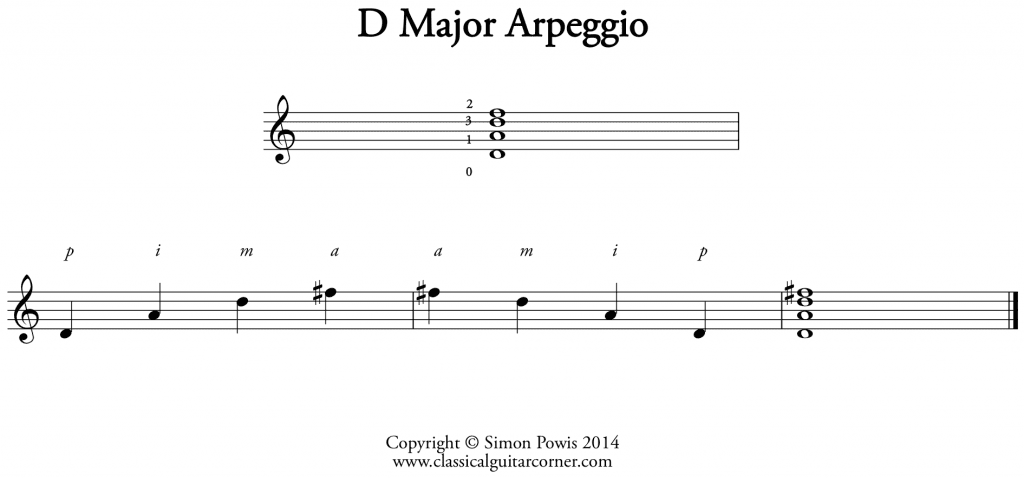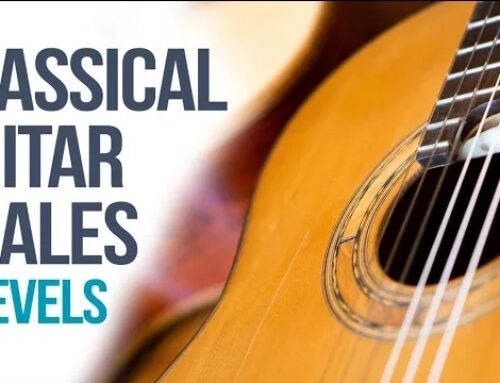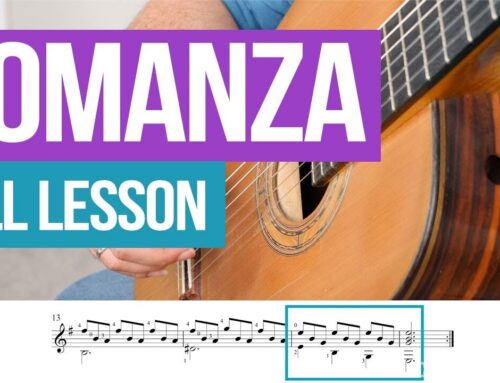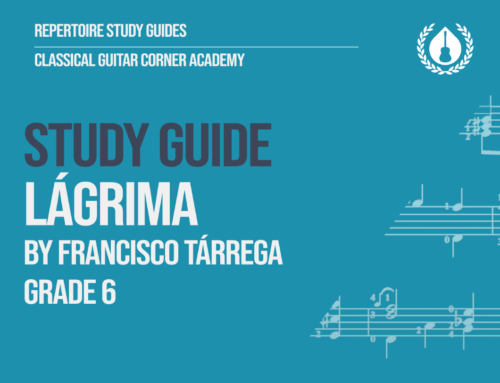Now that we have worked on playing notes together as a chord, lets break them up!
Arpeggios are broken chords, with the notes of any given chord being played one at a time. In this lesson we are going to arpeggiate chords that are held down in one shape by the left hand. In later lessons we will look at arpeggios that involve shifting of the left hand and eventually will span the entire fingerboard!
Lets start with an arpeggio of D major. If you need to cover D major you can look at the Fundamentals Lesson on Chords F110
Set up your Right Hand position on the 4th 3rd 2nd and 1st strings and hold down the D major chord in the left hand. With all the right hand fingers prepared on the strings we can say they are planted.
“Planting”
Planting (or Preparation) is when a finger, or several fingers are placed on the string with the flesh and nail touching the string in preparation to play.
From this position release each finger, one at a time. The P, I, M, then finally A and let the strings ring on as you play them. That is an arpeggio! The D major chord sounds as each string rings on over each other but the notes of the chord were arpeggiated.
Now repeat the process, prepare the fingers on the strings (plant the fingers) and now release them in the opposite order A, M, I, and P…
Not as easy, right?
When playing arpeggios like this we can help the hand by planting when we are playing the chord in an ascending order (low to high in pitch) but when we play from high to low we do not plant the fingers and simply play free stroke.
Try this arpeggio now, planting to prepare the ascending arpeggio and playing free strokes on the way down
The great thing about playing arpeggios is that we can really hear the sounds made by each individual finger in the right hand. If one finger is softer than another, or if the quality of the sound is different we can work on improving our technique.
It will also aid as a tool to develop independence of finger, and we will look at this in Level 2
F. Sor Study No.8 and 9 from: 10 Progressive Pieces for Classical Guitar
Study no.8 – F. Sor
Sor really was a great educator, that is why I like to use his studies. This study is a bump up in terms of complexity, so be patient with your progress on this one. This study features arpeggios which use the thumb and three fingers, it requires you to balance your hand and control the different voices that are in the piece. You can think of the voices as a little choir, and you can see them just by looking at the score. This piece has three distinct voices but because the guitar has only six strings they are sometimes incomplete. Your goal is to control the sound in the right hand and sustain notes for their full rhythmic value in the left hand. The last four measures have some tricky parts, so isolate them and practice them independently until you feel confident.
Study no.9 – F.Sor
Another arpeggio study, this outlines a series of chords in the left hand that get arpeggiated in the right hand. Where study no.8 required you to give balance and control to the right hand, this study is asking for that and a melody in the treble voice. This melody is depicted in the score with longer note values (such as the third beat of the first measure). They share the stem of the other eighth notes but you have to sustain the note for its full rhythmic value. You can experiment with using rest stroke for the melody notes.





How to play arpeggio without nails
I am very good at scale without nail but so scratchy and clumsy at arpeggios